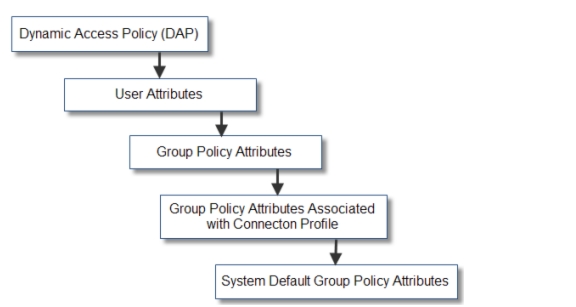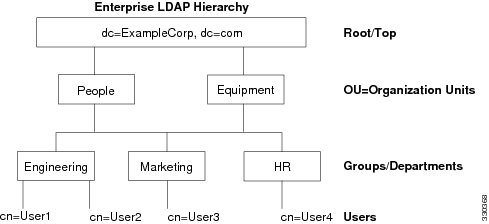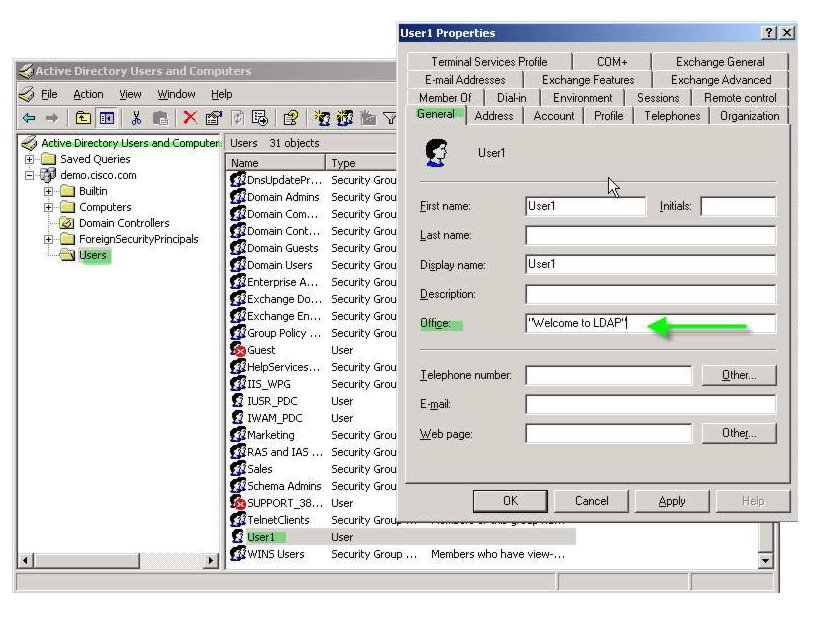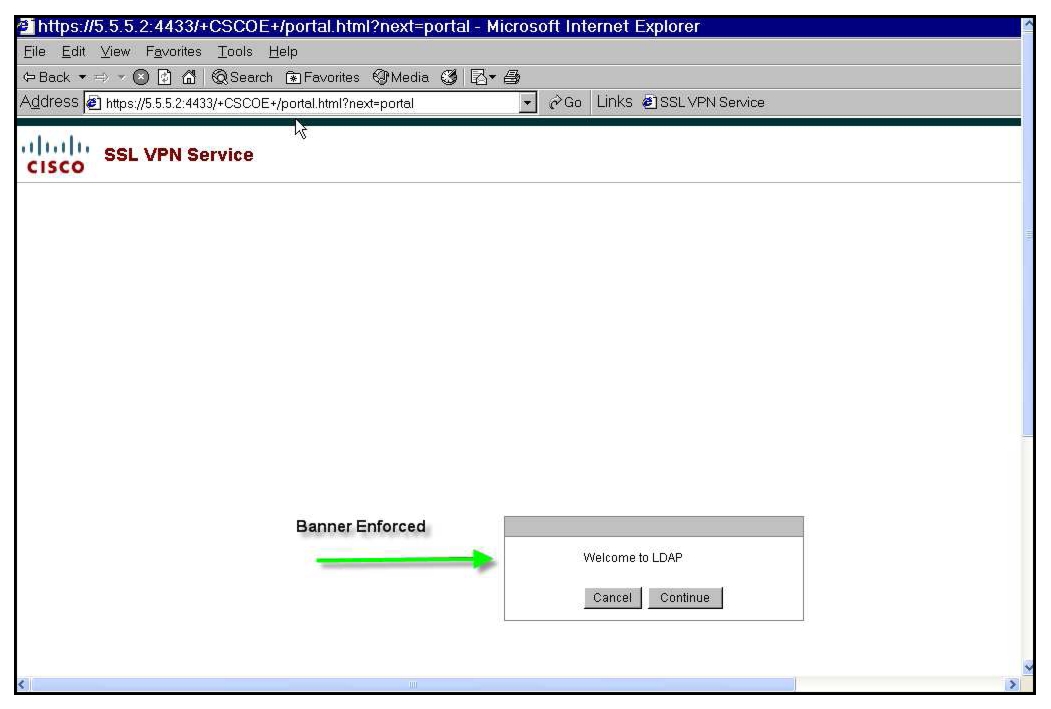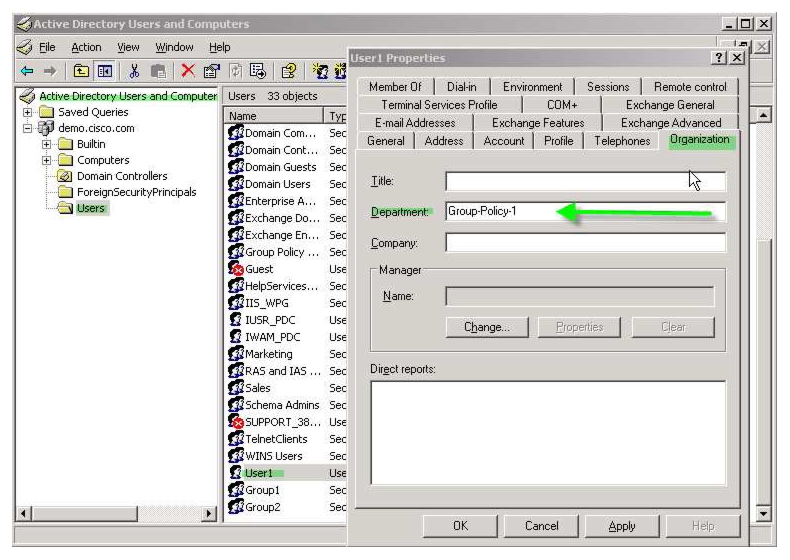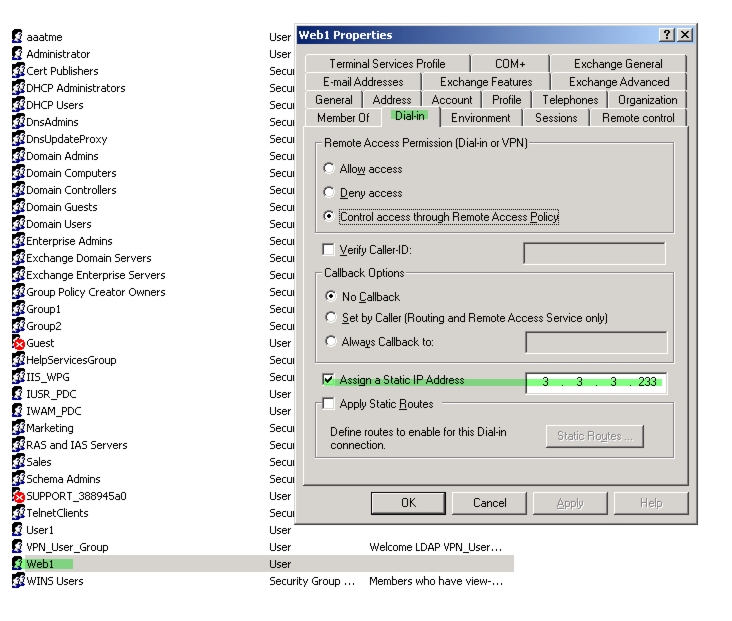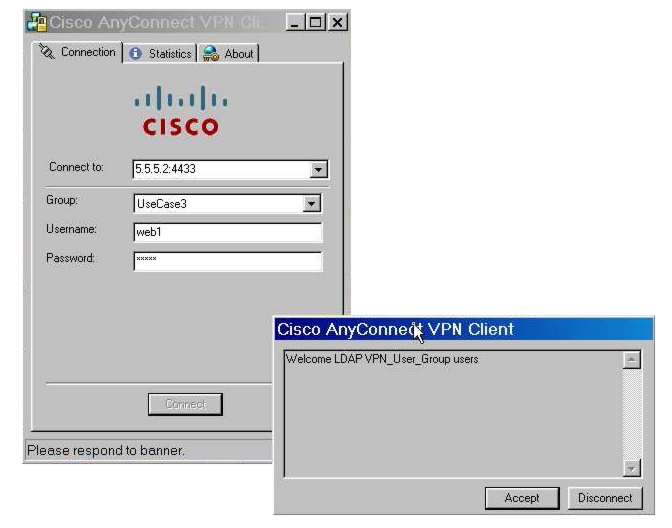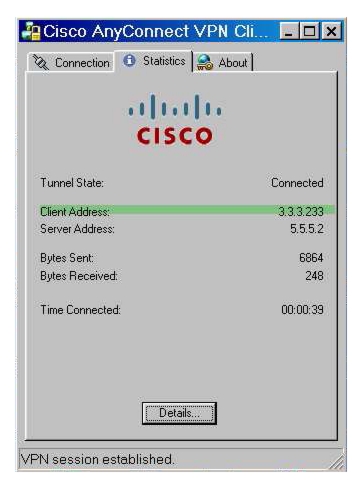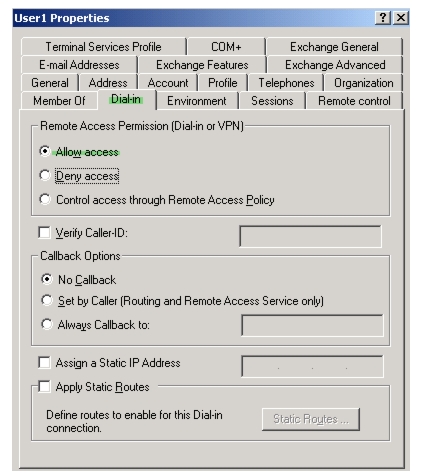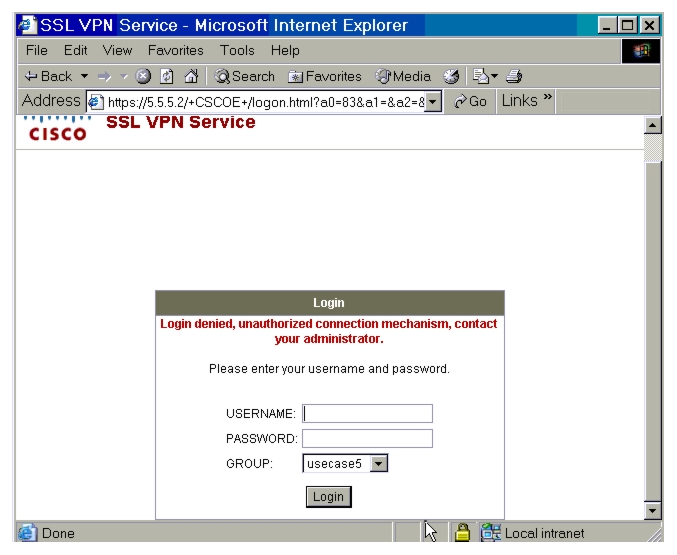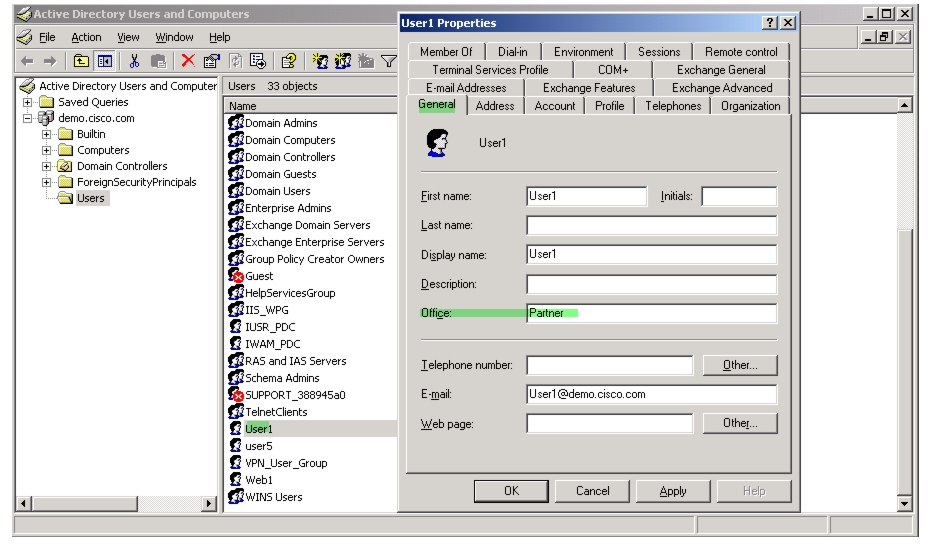

-
Cisco ASA 5500 Series Configuration Guide using the CLI, 8.2
-
About This Guide
-
Glossary
- Getting Started and General Information
- Configuring Access Lists
- Configuring IP Routing
- Configuring NAT
- Configuring High Availability
- Configuring Access Control
- Configuring Application Layer Procotol Inspection
- Configuring Unified Communications
- Configuring Advanced Connection Settings
- Configuring Applications on SSMs and SSCs
-
Configuring VPN
-
Configuring IPSec and ISAKMP
-
Configuring L2TP over IPSec
-
Setting General VPN Parameters
-
Configuring Tunnel Groups, Group Policies, and Users
-
Configuring IP Addresses for VPN
-
Configuring Remote Access VPNs
-
Configuring Network Admission Control
-
Configuring Easy VPN on the ASA 5505
-
Configuring the PPPoE Client
-
Configuring LAN-to-LAN VPNs
-
Configuring Clientless SSL VPN
-
Configuring AnyConnect VPN Client Connections
-
Configuring Certificates
-
- Monitoring
- System Administration
- Reference
-
Table Of Contents
Configuring an External Server for Authorization and Authentication
Understanding Policy Enforcement of Permissions and Attributes
Configuring an External LDAP Server
Organizing the Security Appliance for LDAP Operations
Binding the Security Appliance to the LDAP Server
Login DN Example for Active Directory
Defining the Security Appliance LDAP Configuration
Supported Cisco Attributes for LDAP Authorization
Cisco AV Pair Attribute Syntax
Active Directory/LDAP VPN Remote Access Authorization Use Cases
User-Based Attributes Policy Enforcement
Placing LDAP users in a specific Group-Policy
Enforcing Static IP Address Assignment for AnyConnect Tunnels
Enforcing Dial-in Allow or Deny Access
Enforcing Logon Hours and Time-of-Day Rules
Configuring an External RADIUS Server
Reviewing the RADIUS Configuration Procedure
Security Appliance RADIUS Authorization Attributes
Security Appliance IETF RADIUS Authorization Attributes
Configuring an External TACACS+ Server
Configuring an External Server for Authorization and Authentication
This appendix describes how to configure an external LDAP, RADIUS, or TACACS+ server to support AAA on the ASA. Before you configure the ASA to use an external server, you must configure the server with the correct ASA authorization attributes and, from a subset of these attributes, assign specific permissions to individual users.
This appendix includes the following sections:
•
Understanding Policy Enforcement of Permissions and Attributes
•
Configuring an External LDAP Server
•
Configuring an External RADIUS Server
•
Configuring an External TACACS+ Server
Understanding Policy Enforcement of Permissions and Attributes
The ASA supports several methods of applying user authorization attributes (also called user entitlements or permissions) to VPN connections. You can configure the ASA to obtain user attributes from a Dynamic Access Policy (DAP) on the ASA, from an external authentication and/or authorization AAA server (RADIUS or LDAP), from a group policy on the security appliance, or from all three.
If the security appliance receives attributes from all sources, the attributes are evaluated, merged, and applied to the user policy. If there are conflicts between attributes coming from the DAP, the AAA server, or the group policy, those attributes obtained from the DAP always take precedence.
The security appliance applies attributes in the following order (also illustrated in Figure D-1:
1.
DAP attributes on the ASA—Introduced in Version 8.0, take precedence over all others. If you set a bookmark/URL list in DAP, it overrides a bookmark/URL list set in the group policy.
2.
User attributes on the AAA server—The server returns these after successful user authentication and/or authorization. Do not confuse these with attributes that are set for individual users in the local AAA database on the ASA (User Accounts in ASDM).
3.
Group policy configured on the ASA—If a RADIUS server returns the value of the RADIUS CLASS attribute IETF-Class-25 (OU=<group-policy>) for the user, the ASA places the user in the group policy of the same name and enforces any attributes in the group policy that are not returned by the server.
For LDAP servers, any attribute name can be used to set the group policy for the session. The LDAP attribute map you configure on the ASA maps the LDAP attribute to the Cisco attribute IETF-Radius-Class.
4.
Group policy assigned by the Connection Profile (called tunnel-group in CLI)—The Connection Profile has the preliminary settings for the connection, and includes a default group policy applied to the user before authentication. All users connecting to the ASA initially belong to this group which provides any attributes that are missing from the DAP, user attributes returned by the server, or the group policy assigned to the user.
5.
Default group policy assigned by the ASA (DfltGrpPolicy)—System default attributes provide any values that are missing from the DAP, user attributes, group policy, or connection profile.
Figure D-1 Policy Enforcement Flow
Configuring an External LDAP Server
The VPN 3000 Concentrator and the ASA/PIX 7.0 required a Cisco LDAP schema for authorization operations. Beginning with Version 7.1.x, the ASA performs authentication and authorization, using the native LDAP schema, and the Cisco schema is no longer needed.
You configure authorization (permission policy) using an LDAP attribute map. For examples, see
Active Directory/LDAP VPN Remote Access Authorization Use Cases.This section describes the structure, schema, and attributes of an LDAP server. It includes the following topics:
•
Organizing the Security Appliance for LDAP Operations
•
Defining the Security Appliance LDAP Configuration
•
Active Directory/LDAP VPN Remote Access Authorization Use Cases
The specific steps of these processes vary, depending on which type of LDAP server you are using.
Note
For more information on the LDAP protocol, see RFCs 1777, 2251, and 2849.
Organizing the Security Appliance for LDAP Operations
This section describes how to perform searches within the LDAP hierarchy and authenticated binding to the LDAP server on the ASA. It includes the following topics:
•
Binding the Security Appliance to the LDAP Server
•
Login DN Example for Active Directory
Your LDAP configuration should reflect the logical hierarchy of your organization. For example, suppose an employee at your company, Example Corporation, is named Terry. Terry works in the Engineering group. Your LDAP hierarchy could have one or many levels. You might decide to set up a shallow, single-level hierarchy in which Terry is considered a member of Example Corporation. Or, you could set up a multi-level hierarchy in which Terry is considered to be a member of the department Engineering, which is a member of an organizational unit called People, which is itself a member of Example Corporation. See Figure D-2 for an example of this multi-level hierarchy.
A multi-level hierarchy has more granularity, but a single level hierarchy is quicker to search.
Figure D-2 A Multi-Level LDAP Hierarchy
Searching the Hierarchy
The ASA lets you tailor the search within the LDAP hierarchy. You configure the following three fields on the ASA to define where in the LDAP hierarchy your search begins, the extent, and the type of information it is looking for. Together these fields allow you to limit the search of the hierarchy to only the part of the tree that contains the user permissions.
•
LDAP Base DN defines where in the LDAP hierarchy the server should begin searching for user information when it receives an authorization request from the ASA.
•
Search Scope defines the extent of the search in the LDAP hierarchy. The search proceeds this many levels in the hierarchy below the LDAP Base DN. You can choose to have the server search only the level immediately below, or it can search the entire subtree. A single level search is quicker, but a subtree search is more extensive.
•
Naming Attribute(s) defines the RDN that uniquely identifies an entry in the LDAP server. Common naming attributes can include cn (Common Name), sAMAccountName, and userPrincipalName.
Figure D-2 shows a possible LDAP hierarchy for Example Corporation. Given this hierarchy, you could define your search in different ways. Table D-1 shows two possible search configurations.
In the first example configuration, when Terry establishes the IPSec tunnel with LDAP authorization required, the ASA sends a search request to the LDAP server indicating it should search for Terry in the Engineering group. This search is quick.
In the second example configuration, the ASA sends a search request indicating the server should search for Terry within Example Corporation. This search takes longer.
Binding the Security Appliance to the LDAP Server
Some LDAP servers (including the Microsoft Active Directory server) require the ASA to establish a handshake via authenticated binding before they accept requests for any other LDAP operations. The ASA uses the Login Distinguished Name (DN) and Login Password to establish trust (bind) with an LDAP server. The Login DN represents a user record in the LDAP server that the administrator uses for binding.
When binding, the ASA authenticates to the server using the Login DN and the Login Password. When performing a Microsoft Active Directory read-only operation (such as for authentication, authorization, or group-search), the security appliance can bind with a Login DN with less privileges. For example, the Login DN can be a user whose AD "Member Of" designation is part of Domain Users. For VPN password management operations, the Login DN needs elevated privileges and must be part of the Account Operators AD group.
An example of a Login DN includes:
cn=Binduser1,ou=Admins,ou=Users,dc=company_A,dc=com
The security appliance supports:
•
Simple LDAP authentication with an unencrypted password on port 389
•
Secure LDAP (LDAP-S) on port 636
•
Simple Authentication and Security Layer (SASL) MD5
•
SASL Kerberos.
The security appliance does not support anonymous authentication.
Note
As an LDAP client, the ASA does not support sending anonymous binds or requests.
Login DN Example for Active Directory
The Login DN is a username on the LDAP server that the ASA uses to establish a trust between itself (the LDAP client) and the LDAP server during the Bind exchange, before a user search can take place.
For VPN authentication/authorization operations, and beginning with version 8.0.4 for retrieval of AD Groups, (which are read operations only when password-management changes are not required), the you can use the Login DN with fewer privileges. For example, the Login DN can be a user who is a memberOf the Domain Users group.
For VPN password-management changes, the Login DN must have Account Operators privileges.
In either of these cases, Super-user level privileges are not required for the Login/Bind DN. Refer to your LDAP Administrator guide for specific Login DN requirements.
Defining the Security Appliance LDAP Configuration
This section describes how to define the LDAP AV-pair attribute syntax. It includes the following topics:
•
Supported Cisco Attributes for LDAP Authorization
•
Cisco AV Pair Attribute Syntax
Note
The ASA enforces the LDAP attributes based on attribute name, not numeric ID. RADIUS attributes, on the other hand, are enforced by numeric ID, not by name.
Authorization refers to the process of enforcing permissions or attributes. An LDAP server defined as an authentication or authorization server will enforce permissions or attributes if they are configured.
For software Version 7.0, LDAP attributes include the cVPN3000 prefix. For Version 7.1 and later, this prefix was removed.
Supported Cisco Attributes for LDAP Authorization
This section provides a complete list of attributes (Table D-2) for the ASA 5500, VPN 3000, and PIX 500 series ASAs. The table includes attribute support information for the VPN 3000 and PIX 500 series to assist you configure networks with a mixture of these ASAs.
Table D-2 Security Appliance Supported Cisco Attributes for LDAP Authorization
TypeAccess-Hours
Y
Y
Y
String
Single
Name of the time-range
(for example, Business-Hours)Allow-Network-Extension- Mode
Y
Y
Y
Boolean
Single
0 = Disabled
1 = EnabledAuthenticated-User-Idle- Timeout
Y
Y
Y
Integer
Single
1 - 35791394 minutes
Authorization-Required
Y
Integer
Single
0 = No
1 = YesAuthorization-Type
Y
Integer
Single
0 = None
1 = RADIUS
2 = LDAPBanner1
Y
Y
Y
String
Single
Banner string for clientless and client SSL VPN, and IPSec clients.
Banner2
Y
Y
Y
String
Single
Banner string for clientless and client SSL VPN, and IPSec clients.
Cisco-AV-Pair
Y
Y
Y
String
Multi
An octet string in the following format:
[Prefix] [Action] [Protocol] [Source] [Source Wildcard Mask] [Destination] [Destination Wildcard Mask] [Established] [Log] [Operator] [Port]
For more information, see "Cisco AV Pair Attribute Syntax."
Cisco-IP-Phone-Bypass
Y
Y
Y
Integer
Single
0 = Disabled
1 = EnabledCisco-LEAP-Bypass
Y
Y
Y
Integer
Single
0 = Disabled
1 = EnabledClient-Intercept-DHCP- Configure-Msg
Y
Y
Y
Boolean
Single
0 = Disabled
1 = EnabledClient-Type-Version-Limiting
Y
Y
Y
String
Single
IPSec VPN client version number string
Confidence-Interval
Y
Y
Y
Integer
Single
10 - 300 seconds
DHCP-Network-Scope
Y
Y
Y
String
Single
IP address
DN-Field
Y
Y
Y
String
Single
Possible values: UID, OU, O, CN, L, SP, C, EA, T, N, GN, SN, I, GENQ, DNQ, SER, use-entire-name.
Firewall-ACL-In
Y
Y
String
Single
Access list ID
Firewall-ACL-Out
Y
Y
String
Single
Access list ID
Group-Policy
Y
Y
String
Single
Sets the group policy for the remote access VPN session. For version 8.2 and later, use this attribute instead of IETF-Radius-Class. You can use one of the three following formats:
•
<group policy name>
•
OU=<group policy name>
•
OU=<group policy name>;
IE-Proxy-Bypass-Local
Boolean
Single
0=Disabled
1=EnabledIE-Proxy-Exception-List
String
Single
A list of DNS domains. Entries must be separated by the new line character sequence (\n).
IE-Proxy-Method
Y
Y
Y
Integer
Single
1 = Do not modify proxy settings
2 = Do not use proxy
3 = Auto detect
4 = Use ASA settingIE-Proxy-Server
Y
Y
Y
Integer
Single
IP Address
IETF-Radius-Class
Y
Y
Y
Single
Sets the group policy for the remote access VPN session. For version 8.2 and later, we recommend that you use the Group-Policy attribute. You can use one of the three following formats:
•
<group policy name>
•
OU=<group policy name>
•
OU=<group policy name>;
IETF-Radius-Filter-Id
Y
Y
Y
String
Single
access list name that is defined on the ASA
IETF-Radius-Framed-IP-Address
Y
Y
Y
String
Single
An IP address
IETF-Radius-Framed-IP-Netmask
Y
Y
Y
String
Single
An IP address mask
IETF-Radius-Idle-Timeout
Y
Y
Y
Integer
Single
seconds
IETF-Radius-Service-Type
Y
Y
Y
Integer
Single
1 = Login
2 = Framed
6 = Administrative
7 = NAS PromptIETF-Radius-Session-Timeout
Y
Y
Y
Integer
Single
seconds
IKE-Keep-Alives
Y
Y
Y
Boolean
Single
0 = Disabled
1 = EnabledIPSec-Allow-Passwd-Store
Y
Y
Y
Boolean
Single
0 = Disabled
1 = EnabledIPSec-Authentication
Y
Y
Y
Integer
Single
0 = None
1 = RADIUS
2 = LDAP (authorization only)
3 = NT Domain
4 = SDI (RSA)
5 = Internal
6 = RADIUS with Expiry
7 = Kerberos/Active DirectoryIPSec-Auth-On-Rekey
Y
Y
Y
Boolean
Single
0 = Disabled
1 = EnabledIPSec-Backup-Server-List
Y
Y
Y
String
Single
Server Addresses (space delimited)
IPSec-Backup-Servers
Y
Y
Y
String
Single
1 = Use Client-Configured list
2 = Disabled and clear client list
3 = Use Backup Server listIPSec-Client-Firewall-Filter- Name
Y
String
Single
Specifies the name of the filter to be pushed to the client as firewall policy.
IPSec-Client-Firewall-Filter- Optional
Y
Y
Y
Integer
Single
0 = Required
1 = OptionalIPSec-Default-Domain
Y
Y
Y
String
Single
Specifies the single default domain name to send to the client (1 - 255 characters).
IPSec-Extended-Auth-On-Rekey
Y
Y
String
Single
IPSec-IKE-Peer-ID-Check
Y
Y
Y
Integer
Single
1 = Required
2 = If supported by peer certificate
3 = Do not checkIPSec-IP-Compression
Y
Y
Y
Integer
Single
0 = Disabled
1 = EnabledIPSec-Mode-Config
Y
Y
Y
Boolean
Single
0 = Disabled
1 = EnabledIPSec-Over-UDP
Y
Y
Y
Boolean
Single
0 = Disabled
1 = EnabledIPSec-Over-UDP-Port
Y
Y
Y
Integer
Single
4001 - 49151; default = 10000
IPSec-Required-Client-Firewall-
CapabilityY
Y
Y
Integer
Single
0 = None
1 = Policy defined by remote FW Are-You-There (AYT)
2 = Policy pushed CPP
4 = Policy from serverIPSec-Sec-Association
Y
String
Single
Name of the security association
IPSec-Split-DNS-Names
Y
Y
Y
String
Single
Specifies the list of secondary domain names to send to the client (1 - 255 characters).
IPSec-Split-Tunneling-Policy
Y
Y
Y
Integer
Single
0 = Tunnel everything
1 = Split tunneling
2 = Local LAN permittedIPSec-Split-Tunnel-List
Y
Y
Y
String
Single
Specifies the name of the network or access list that describes the split tunnel inclusion list.
IPSec-Tunnel-Type
Y
Y
Y
Integer
Single
1 = LAN-to-LAN
2 = Remote accessIPSec-User-Group-Lock
Y
Boolean
Single
0 = Disabled
1 = EnabledL2TP-Encryption
Y
Integer
Single
Bitmap:
1 = Encryption required
2 = 40 bit
4 = 128 bits
8 = Stateless-Req
15 = 40/128-Encr/Stateless-ReqL2TP-MPPC-Compression
Y
Integer
Single
0 = Disabled
1 = EnabledMS-Client-Subnet-Mask
Y
Y
Y
String
Single
An IP address
PFS-Required
Y
Y
Y
Boolean
Single
0 = No
1 = YesPort-Forwarding-Name
Y
Y
String
Single
Name string (for example, "Corporate-Apps")
PPTP-Encryption
Y
Integer
Single
Bitmap:
1 = Encryption required
2 = 40 bits
4 = 128 bits
8 = Stateless-RequiredExample:
15 = 40/128-Encr/Stateless-ReqPPTP-MPPC-Compression
Y
Integer
Single
0 = Disabled
1 = EnabledPrimary-DNS
Y
Y
Y
String
Single
An IP address
Primary-WINS
Y
Y
Y
String
Single
An IP address
Privilege-Level
Required-Client- Firewall-Vendor-Code
Y
Y
Y
Integer
Single
1 = Cisco Systems (with Cisco Integrated Client)
2 = Zone Labs
3 = NetworkICE
4 = Sygate
5 = Cisco Systems (with Cisco Intrusion Prevention Security Agent)Required-Client-Firewall- Description
Y
Y
Y
String
Single
String
Required-Client-Firewall- Product-Code
Y
Y
Y
Integer
Single
Cisco Systems Products:
1 = Cisco Intrusion Prevention Security Agent or Cisco Integrated Client (CIC)
Zone Labs Products:
1 = Zone Alarm
2 = Zone AlarmPro
3 = Zone Labs IntegrityNetworkICE Product:
1 = BlackIce Defender/Agent
Sygate Products:
1 = Personal Firewall
2 = Personal Firewall Pro
3 = Security AgentRequire-HW-Client-Auth
Y
Y
Y
Boolean
Single
0 = Disabled
1 = EnabledRequire-Individual-User-Auth
Y
Y
Y
Integer
Single
0 = Disabled
1 = EnabledSecondary-DNS
Y
Y
Y
String
Single
An IP address
Secondary-WINS
Y
Y
Y
String
Single
An IP address
SEP-Card-Assignment
Integer
Single
Not used
Simultaneous-Logins
Y
Y
Y
Integer
Single
0-2147483647
Strip-Realm
Y
Y
Y
Boolean
Single
0 = Disabled
1 = EnabledTACACS-Authtype
Y
Y
Y
Interger
Single
TACACS-Privilege-Level
Y
Y
Y
Interger
Single
Tunnel-Group-Lock
Y
Y
String
Single
Name of the tunnel group or "none"
Tunneling-Protocols
Y
Y
Y
Integer
Single
1 = PPTP
2 = L2TP
4 = IPSec
8 = L2TP/IPSec
16 = WebVPN
32 = SVC
8 and 4 are mutually exclusive
(0 - 11, 16 - 27, 32 - 43, 48 - 59 are legal values)Use-Client-Address
Y
Boolean
Single
0 = Disabled
1 = EnabledUser-Auth-Server-Name
Y
String
Single
IP address or hostname
User-Auth-Server-Port
Y
Integer
Single
Port number for server protocol
User-Auth-Server-Secret
Y
String
Single
Server password
WebVPN-ACL-Filters
Y
String
Single
Webtype Access-List name
WebVPN-Apply-ACL-Enable
Y
Y
Integer
Single
0 = Disabled
1 = EnabledWith version 8.0 and later, this attribute is not required.
WebVPN-Citrix-Support-Enable
Y
Y
Integer
Single
0 = Disabled
1 = EnabledWith version 8.0 and later, this attribute is not required.
WebVPN-Enable-functions
Integer
Single
Not used - deprecated
WebVPN-Exchange-Server- Address
String
Single
Not used - deprecated
WebVPN-Exchange-Server- NETBIOS-Name
String
Single
Not used - deprecated
WebVPN-File-Access-Enable
Y
Y
Integer
Single
0 = Disabled
1 = EnabledWebVPN-File-Server-Browsing-
EnableY
Y
Integer
Single
0 = Disabled
1 = EnabledWebVPN-File-Server-Entry- Enable
Y
Y
Integer
Single
0 = Disabled
1 = EnabledWebVPN-Forwarded-Ports
Y
String
Single
Port-Forward list name
WebVPN-Homepage
Y
Y
String
Single
A URL such as http://example-portal.com.
WebVPN-Macro-Substitution-
Value1Y
Y
String
Single
See SSL VPN Deployment Guide for examples and use cases at this URL:
http://supportwiki.cisco.com/ViewWiki/index.php/Cisco_ASA_5500_SSL_VPN_Deployment_Guide%2C_Version_8.x
WebVPN-Macro-Substitution-
Value2Y
Y
String
Single
See SSL VPN Deployment Guide for examples and use cases at this URL:
http://supportwiki.cisco.com/ViewWiki/index.php/Cisco_ASA_5500_SSL_VPN_Deployment_Guide%2C_Version_8.x
WebVPN-Port-Forwarding- Auto-Download-Enable
Y
Y
Integer
Single
0 = Disabled
1 = EnabledWebVPN-Port-Forwarding- Enable
Y
Y
Integer
Single
0 = Disabled
1 = EnabledWebVPN-Port-Forwarding- Exchange-Proxy-Enable
Y
Y
Integer
Single
0 = Disabled
1 = EnabledWebVPN-Port-Forwarding- HTTP-Proxy-Enable
Y
Y
Integer
Single
0 = Disabled
1 = EnabledWebVPN-Single-Sign-On- Server-Name
Y
String
Single
Name of the SSO Server (1 - 31 characters).
WebVPN-SVC-Client-DPD
Y
Y
Integer
Single
0 = Disabled
n = Dead Peer Detection value in seconds (30 - 3600)WebVPN-SVC-Compression
Y
Y
Integer
Single
0 = None
1 = Deflate CompressionWebVPN-SVC-Enable
Y
Y
Integer
Single
0 = Disabled
1 = EnabledWebVPN-SVC-Gateway-DPD
Y
Y
Integer
Single
0 = Disabled
n = Dead Peer Detection value in seconds (30 - 3600)WebVPN-SVC-Keepalive
Y
Y
Integer
Single
0 = Disabled
n = Keepalive value in seconds (15 - 600)WebVPN-SVC-Keep-Enable
Y
Y
Integer
Single
0 = Disabled
1 = EnabledWebVPN-SVC-Rekey-Method
Y
Y
Integer
Single
0 = None
1 = SSL
2 = New tunnel
3 = Any (sets to SSL)WebVPN-SVC-Rekey-Period
Y
Y
Integer
Single
0 = Disabled
n = Retry period in minutes
(4 - 10080)WebVPN-SVC-Required-Enable
Y
Y
Integer
Single
0 = Disabled
1 = EnabledWebVPN-URL-Entry-Enable
Y
Y
Integer
Single
0 = Disabled
1 = EnabledWebVPN-URL-List
Y
String
Single
URL-list name
Cisco AV Pair Attribute Syntax
The Cisco Attribute Value (AV) pair (ID# 26/9/1) can be used to enforce access lists from a Radius server (like Cisco ACS), or from an LDAP server via an ldap-attribute-map.
The syntax of each Cisco-AV-Pair rule is as follows:
[Prefix] [Action] [Protocol] [Source] [Source Wildcard Mask] [Destination] [Destination Wildcard Mask] [Established] [Log] [Operator] [Port]
Table D-3 describes the syntax rules.
Cisco AV Pairs ACL Examples
Table D-4 shows examples of Cisco AV pairs and describes the allow or deny actions that result.
Note
Each ACL # in inacl# must be unique. However, they do not need to be sequential (i.e. 1, 2, 3, 4). For example, they could be 5, 45, 135.
Table D-4 Examples of Cisco AV Pairs and their Permitting or Denying Action
URL Types supported in ACLs
The URL may be a partial URL, contain wildcards for the server, or contain a port.
The following URL types are supported:
any All URLs
http://
nfs://
sametime://
telnet://
cifs://
https://
pop3://
smart-tunnel://
tn3270://
citrix://
ica://
post://
smtp://
tn5250://
citrixs://
imap4://
rdp://
ssh://
vnc://
ftp://
Note
The URLs listed above appear in CLI or ASDM menus based on whether the associated plugin is enabled.
Guidelines for using Cisco-AV Pairs (ACLs)
•
Use Cisco-AV pair entries with the ip:inacl# prefix to enforce access lists for remote IPSec and SSL VPN Client (SVC) tunnels.
•
Use Cisco-AV pair entries with the webvpn:inacl# prefix to enforce access lists for SSL VPN clientless (browser-mode) tunnels.
•
For Webtype ACLs, you don't specify the source because the ASA is the source.
Table D-5 lists the tokens for the Cisco-AV-pair attribute:
Active Directory/LDAP VPN Remote Access Authorization Use Cases
This section presents example procedures for configuring authentication and authorization on the ASA using the Microsoft Active Directory server. It includes the following use cases:
•
User-Based Attributes Policy Enforcement
•
Placing LDAP users in a specific Group-Policy
•
Enforcing Static IP Address Assignment for AnyConnect Tunnels
•
Enforcing Dial-in Allow or Deny Access
•
Enforcing Logon Hours and Time-of-Day Rules
Other configuration examples available on Cisco.com include the following TechNotes:
•
ASA/PIX: Mapping VPN Clients to VPN Group Policies Through LDAP Configuration Example at:
http://www.cisco.com/en/US/products/ps6120/products_configuration_example09186a008089149d.shtml
•
PIX/ASA 8.0: Use LDAP Authentication to Assign a Group Policy at Login at:
http://www.cisco.com/en/US/partner/products/ps6120/products_configuration_example09186a00808d1a7c.shtml
User-Based Attributes Policy Enforcement
Any standard LDAP attribute can be mapped to a well-known Vendor Specific Attribute (VSA) Likewise, one or more LDAP attribute(s) can be mapped to one or more Cisco LDAP attributes.
In this use case we configure the ASA to enforce a simple banner for a user configured on an AD LDAP server. For this case, on the server, we use the Office field in the General tab to enter the banner text. This field uses the attribute named physicalDeliveryOfficeName. On the ASA, we create an attribute map that maps physicalDeliveryOfficeName to the Cisco attribute Banner1. During authentication, the ASA retrieves the value of physicalDeliveryOfficeName from the server, maps the value to the Cisco attribute Banner1, and displays the banner to the user.
This case applies to any connection type, including the IPSec VPN client, AnyConnect SSL VPN client, or clientless SSL VPN. For the purposes of this case, User1 is connecting through a clientless SSL VPN connection.
Step 1
Configure the attributes for a user on the AD/LDAP Server.
Right-click a user. The properties window displays (Figure D-3). Click the General tab and enter some banner text in the Office field. The Office field uses the AD/LDAP attribute physicalDeliveryOfficeName.
Figure D-3 Figure 3 LDAP User configuration
Step 2
Create an LDAP attribute map on the ASA:
The following example creates the map Banner, and maps the AD/LDAP attribute physicalDeliveryOfficeName to the Cisco attribute Banner1:
hostname(config)# ldap attribute-map Bannerhostname(config-ldap-attribute-map)# map-name physicalDeliveryOfficeName Banner1Step 3
Associate the LDAP attribute map to the AAA server.
The following example enters the aaa server host configuration more for the host 3.3.3.4, in the AAA server group MS_LDAP, and associates the attribute map Banner that you created in step 2:
hostname(config)# aaa-server MS_LDAP host 3.3.3.4hostname(config-aaa-server-host)# ldap-attribute-map BannerStep 4
Test the banner enforcement.
This example shows a clientless SSL connection and the banner enforced through the attribute map after the user authenticates (Figure D-4).
Figure D-4 Banner Displayed
Placing LDAP users in a specific Group-Policy
In this case we authenticate User1 on the AD LDAP server to a specific group policy on the ASA. On the server, we use the Department field of the Organization tab to enter the name of the group policy. Then we create an attribute map and map Department to the Cisco attribute IETF-Radius-Class. During authentication, the ASA retrieves the value of Department from the server, maps the value to the IETF-Radius-Class, and places User1 in the group policy.
This case applies to any connection type, including the IPSec VPN client, AnyConnect SSL VPN client, or clientless SSL VPN. For the purposes of this case, user1 is connecting through a clientless SSL VPN connection.
Step 1
Configure the attributes for the user on the AD LDAP Server.
Right-click the user. The Properties window displays (Figure D-5). Click the Organization tab and enter Group-Policy-1 in the Department field.
Figure D-5 AD LDAP Department attribute
Step 2
Define an attribute map for the LDAP configuration shown in Step 1.
In this case we map the AD attribute Department to the Cisco attribute IETF-Radius-Class. For example:
hostname(config)# ldap attribute-map group_policyhostname(config-ldap-attribute-map)# map-name Department IETF-Radius-ClassStep 3
Associate the LDAP attribute map to the AAA server.
The following example enters the aaa server host configuration mode for the host 3.3.3.4, in the AAA server group MS_LDAP, and associates the attribute map group_policy that you created in step 2:
hostname(config)# aaa-server MS_LDAP host 3.3.3.4hostname(config-aaa-server-host)# ldap-attribute-map group_policyStep 4
Add the new group-policy on the ASA and configure the required policy attributes that will be assigned to the user. For this case, we created the Group-policy-1, the name entered in the Department field on the server:
hostname(config)# group-policy Group-policy-1 external server-group LDAP_demohostname(config-aaa-server-group)#Step 5
Establish the VPN connection as the user would, and verify that the session inherits the attributes from Group-Policy1 (and any other applicable attributes from the default group-policy)
You can monitor the communication between the ASA and the server by enabling the debug ldap 255 command from privileged EXEC mode. Below is sample output of this command. The output has been edited to provide the key messages:
[29] Authentication successful for user1 to 3.3.3.4
[29] Retrieving user attributes from server 3.3.3.4
[29] Retrieved Attributes:
[29] department: value = Group-Policy-1
[29] mapped to IETF-Radius-Class: value = Group-Policy-1
Enforcing Static IP Address Assignment for AnyConnect Tunnels
In this case we configure the AnyConnect client user Web1 to receive a static IP Address. We enter the address in the Assign Static IP Address field of the Dialin tab on the AD LDAP server. This field uses the msRADIUSFramedIPAddress attribute. We create an attribute map that maps it to the Cisco attribute IETF-Radius-Framed-IP-Address.
During authentication, the ASA retrieves the value of msRADIUSFramedIPAddress from the server, maps the value to the Cisco attribute IETF-Radius-Framed-IP-Address, and provides the static address to User1 .
This case applies to full-tunnel clients, including the IPSec client and the SSL VPN clients (AnyConnect client 2.x and the legacy SSL VPN client).
Step 1
Configure the user attributes on the AD LDAP server.
Right-click on the user name. The Properties window displays (Figure D-6). Click the Dialin tab, check Assign Static IP Address, and enter an IP address. For this case we use 3.3.3.233.
Figure D-6 Assign Static IP Address
Step 2
Create an attribute map for the LDAP configuration shown in Step 1.
In this case we map the AD attribute msRADIUSFramedIPAddress used by the Static Address field to the Cisco attribute IETF-Radius-Framed-IP-Address.
For example:
hostname(config)# ldap attribute-map static_addresshostname(config-ldap-attribute-map)# map-name msRADIUSFramedIPAddress IETF-Radius-Framed-IP-AddressStep 3
Associate the LDAP attribute map to the AAA server.
The following example enters the aaa server host configuration mode for the host 3.3.3.4, in the AAA server group MS_LDAP, and associates the attribute map static_address that you created in step 2:
hostname(config)# aaa-server MS_LDAP host 3.3.3.4hostname(config-aaa-server-host)# ldap-attribute-map static_addressStep 4
Verify the vpn-address-assigment command is configured to specify aaa by viewing this part of the configuration with the show run all vpn-addr-assign command:
vpn-addr-assign aaa
hostname(config)# show run all vpn-addr-assignvpn-addr-assign aaa <<<< ensure this configured.no vpn-addr-assign dhcpvpn-addr-assign localhostname(config)#Step 5
Establish a connection to the ASA with the AnyConnect client. Observe the following:
•
The banner is received in the same sequence as a clientless connection (Figure D-7).
•
The user receives the IP address configured on the server and mapped to the ASA (Figure D-8).
Figure D-7 Verify the Banner for the AnyConnect Session
Figure D-8 AnyConnect Session Established
You can use the show vpn-sessiondb svc command to view the session details and verify the address assigned:
hostname# show vpn-sessiondb svcSession Type: SVCUsername : web1 Index : 31Assigned IP : 3.3.3.233 Public IP : 10.86.181.70Protocol : Clientless SSL-Tunnel DTLS-TunnelEncryption : RC4 AES128 Hashing : SHA1Bytes Tx : 304140 Bytes Rx : 470506Group Policy : VPN_User_Group Tunnel Group : UseCase3_TunnelGroupLogin Time : 11:13:05 UTC Tue Aug 28 2007Duration : 0h:01m:48sNAC Result : UnknownVLAN Mapping : N/A VLAN : noneBXB-ASA5540#Enforcing Dial-in Allow or Deny Access
In this case, we create an LDAP attribute map that specifies the tunneling protocols allowed by the user. We map the Allow Access and Deny Access settings on the Dialin tab to the Cisco attribute Tunneling-Protocols. The Cisco Tunneling-Protocols supports the bit-map values shown in Table D-6:
Table D-6 Bitmap Values for Cisco Tunneling-Protocol Attribute
1
PPTP
2
L2TP
41
IPSec
82
L2TP/IPSEC
16
clientless SSL
32
SSL Client—AnyConnect or legacy SSL VPN client
1 IPSec and L2TP over IPSec are not supported simultaneously. Therefore, the values 4 and 8 are mutually exclusive.
2 See note 1.
Using this attribute, we create an Allow Access (TRUE) or a Deny Access (FALSE) condition for the protocols and enforce what method the user is allowed access with.
For this simplified example, by mapping the tunnel-protocol IPSec (4), we can create an allow (true) condition for the IPSec Client. We also map WebVPN (16) and SVC/AC (32) which is mapped as value of 48 (16+32) and create a deny (false) condition. This allows the user to connect to the ASA using IPSec, but any attempt to connect using clientless SSL or the AnyConnect client is denied.
Another example of enforcing Dial-in Allow Acess or Deny Access can be found in the Tech Note ASA/PIX: Mapping VPN Clients to VPN Group Policies Through LDAP Configuration Example, at this URL:
http://www.cisco.com/en/US/products/ps6120/products_configuration_example09186a008089149d.shtml
Step 1
Configure the user attributes on the AD LDAP server.
Right-click on the user. The Properties window displays. Click the Dial-in tab. Select Allow Access (Figure D-9).
Figure D-9 AD-LDAP user1 - Allow access
Note
If you select the third option "Control access through the Remote Access Policy", then a value is not returned from the server, and the permissions that are enforced are based on the internal group policy settings of the ASA.
Step 2
Create an attribute map to allow both an IPSec and AnyConnect connection, but deny a clientless SSL connection.
In this case we create the map tunneling_protocols, and map the AD attribute msNPAllowDialin used by the Allow Access setting to the Cisco attribute Tunneling-Protocols using the map-name command, and add map values with the map-value command,
For example:
hostname(config)# ldap attribute-map tunneling_protocolshostname(config-ldap-attribute-map)# map-name msNPAllowDialin Tunneling-Protocolshostname(config-ldap-attribute-map)# map-value msNPAllowDialin FALSE 48hostname(config-ldap-attribute-map)# map-value msNPAllowDialin TRUE 4Step 3
Associate the LDAP attribute map to the AAA server.
The following example enters the aaa server host configuration mode for the host 3.3.3.4, in the AAA server group MS_LDAP, and associates the attribute map tunneling_protocols that you created in step 2:
hostname(config)# aaa-server MS_LDAP host 3.3.3.4hostname(config-aaa-server-host)# ldap-attribute-map tunneling_protocolsStep 4
Verify the attribute map works as configured.
Using a PC as a remote user would, attempt connections using clientless SSL, the AnyConnect client, and the IPSec client. The clientless and AnyConnect connections should fail and the user should be informed that an unauthorized connection mechanism was the reason for the failed connection. The IPSec client should connect because IPSec is an allowed tunneling protocol according to attribute map.
Figure D-10 Login Denied Message for Clientless User
Figure D-11 Login Denied Message for AnyConnect Client User.
Enforcing Logon Hours and Time-of-Day Rules
In this use case we configure and enforce the hours that a clientless SSL user is allowed to access the network. A good example of this is when you want to allow a business partner access to the network only during normal business hours.
For this case, on the AD server, we use the Office field to enter the name of the partner. This field uses the physicalDeliveryOfficeName attribute. Then we create an attribute map on the ASA to map that attribute to the Cisco attribute Access-Hours. During authentication, the ASA retrieves the value of physicalDeliveryOfficeName (the Office field) and maps it to Access-Hours.
Step 1
Configure the user attributes on the AD LDAP server.
Select the user. Right click on Properties. The Properties window displays (Figure D-12). For this case, we use the Office field of the General tab:
Figure D-12 Active Directory - Time-range
Step 2
Create an attribute map.
In this case we create the attribute map access_hours and map the AD attribute physicalDeliveryOfficeName used by the Office field to the Cisco attribute Access-Hours.
For example:
hostname(config)# ldap attribute-map access_hourshostname(config-ldap-attribute-map)# map-name physicalDeliveryOfficeName Access-HoursStep 3
Associate the LDAP attribute map to the AAA server.
The following example enters the aaa server host configuration mode for the host 3.3.3.4, in the AAA server group MS_LDAP, and associates the attribute map access_hours that you created in step 2:
hostname(config)# aaa-server MS_LDAP host 3.3.3.4hostname(config-aaa-server-host)# ldap-attribute-map access_hoursStep 4
Configure time ranges for each value allowed on the server. In this case, we entered Partner in the Office field for User1. Therefore, there must be a time range configured for Partner. The following example configures Partner access hours from 9am to 5pm Monday through Friday:
hostname(config)# time-range Partnerhostname(config-time-range)# periodic weekdays 09:00 to 17:00
Configuring an External RADIUS Server
This section presents an overview of the RADIUS configuration procedure and defines the Cisco RADIUS attributes. It includes the following topics:
•
Reviewing the RADIUS Configuration Procedure
•
Security Appliance RADIUS Authorization Attributes
•
Security Appliance IETF RADIUS Authorization Attributes
Reviewing the RADIUS Configuration Procedure
This section describes the RADIUS configuration steps required to support authentication and authorization of the ASA users. Follow these steps to set up the RADIUS server to inter operate with the ASA.
Step 1
Load the ASA attributes into the RADIUS server. The method you use to load the attributes depends on which type of RADIUS server you are using:
•
If you are using Cisco ACS: the server already has these attributes integrated. You can skip this step.
•
For other vendors' RADIUS servers (for example, Microsoft Internet Authentication Service): you must manually define each ASA attribute. To define an attribute, use the attribute name or number, type, value, and vendor code (3076). For a list of ASA RADIUS authorization attributes and values, see
Step 2
Set up the users or groups with the permissions and attributes to send during IPSec or SSL tunnel establishment.
Security Appliance RADIUS Authorization Attributes
Authorization refers to the process of enforcing permissions or attributes. A RADIUS server defined as an authentication server enforces permissions or attributes if they are configured.
Table D-7 lists all the possible ASA supported RADIUS attributes that can be used for user authorization.
Note
RADIUS attribute names do not contain the cVPN3000 prefix. Cisco Secure ACS 4.x supports this new nomenclature, but attribute names in pre-4.0 ACS releases still include the cVPN3000 prefix. The appliances enforce the RADIUS attributes based on attribute numeric ID, not attribute name. LDAP attributes are enforced by their name, not by the ID.
Security Appliance IETF RADIUS Authorization Attributes
Table D-8 list all the possible IETF Radius attributes.
Configuring an External TACACS+ Server
The ASA provides support for TACACS+ attributes. TACACS+ separates the functions of authentication, authorization, and accounting. The protocol supports two types of attributes: mandatory and optional. Both the server and client must understand a mandatory attribute, and the mandatory attribute must be applied to the user. An optional attribute may or may not be understood or used.
Note
To use TACACS+ attributes, make sure you have enabled AAA services on the NAS.
Table D-9 lists supported TACACS+ authorization response attributes for cut-through-proxy connections. Table D-10 lists supported TACACS+ accounting attributes.
.

 Feedback
Feedback